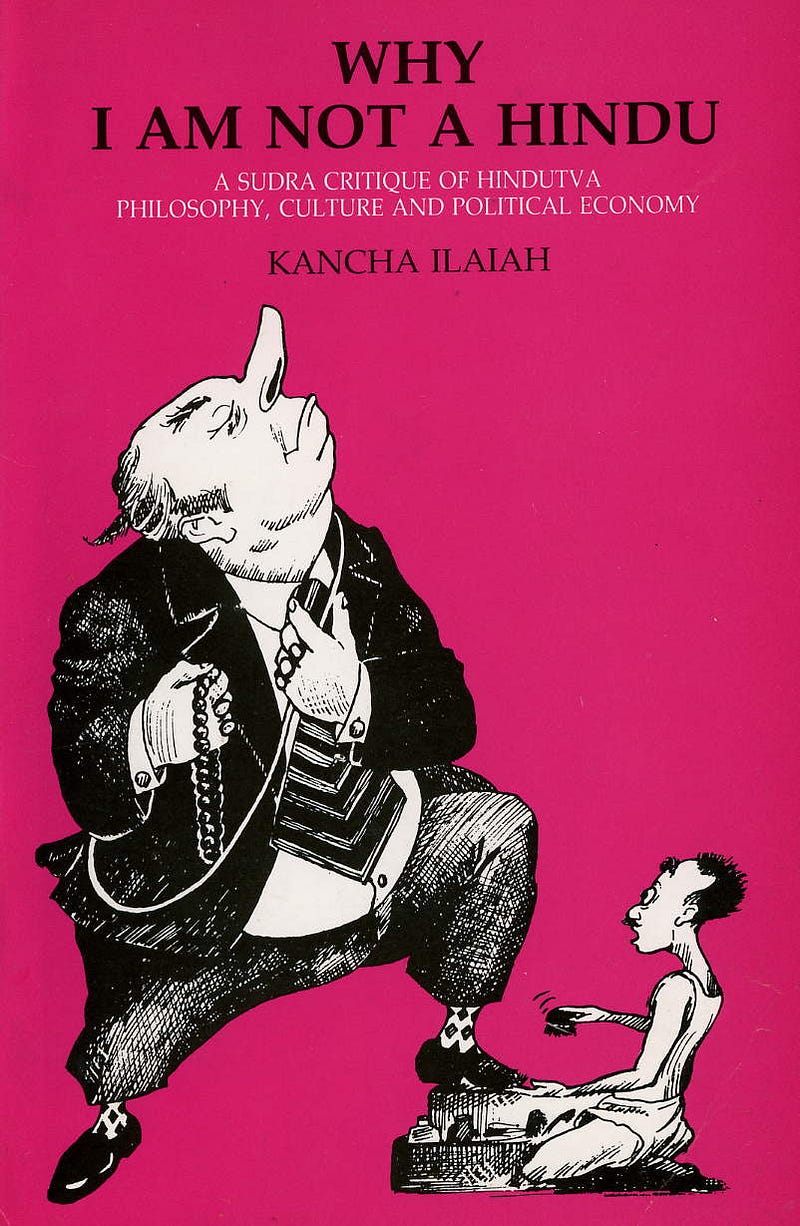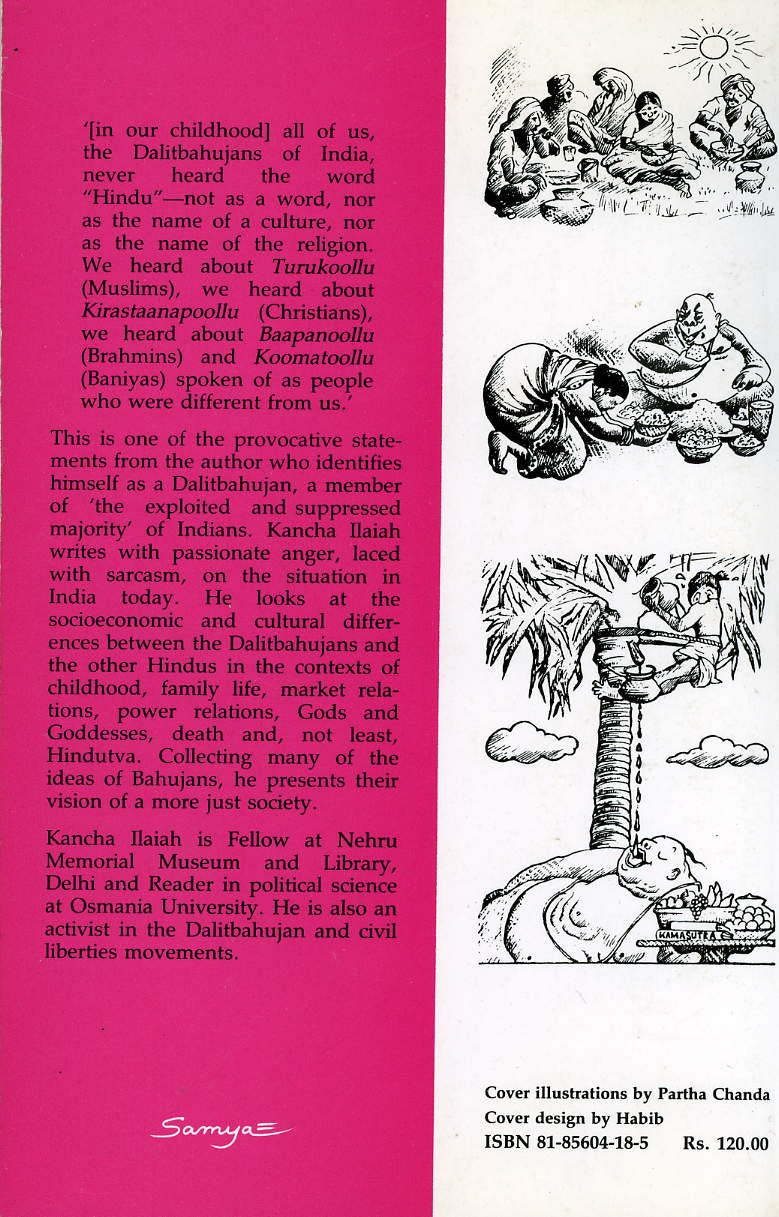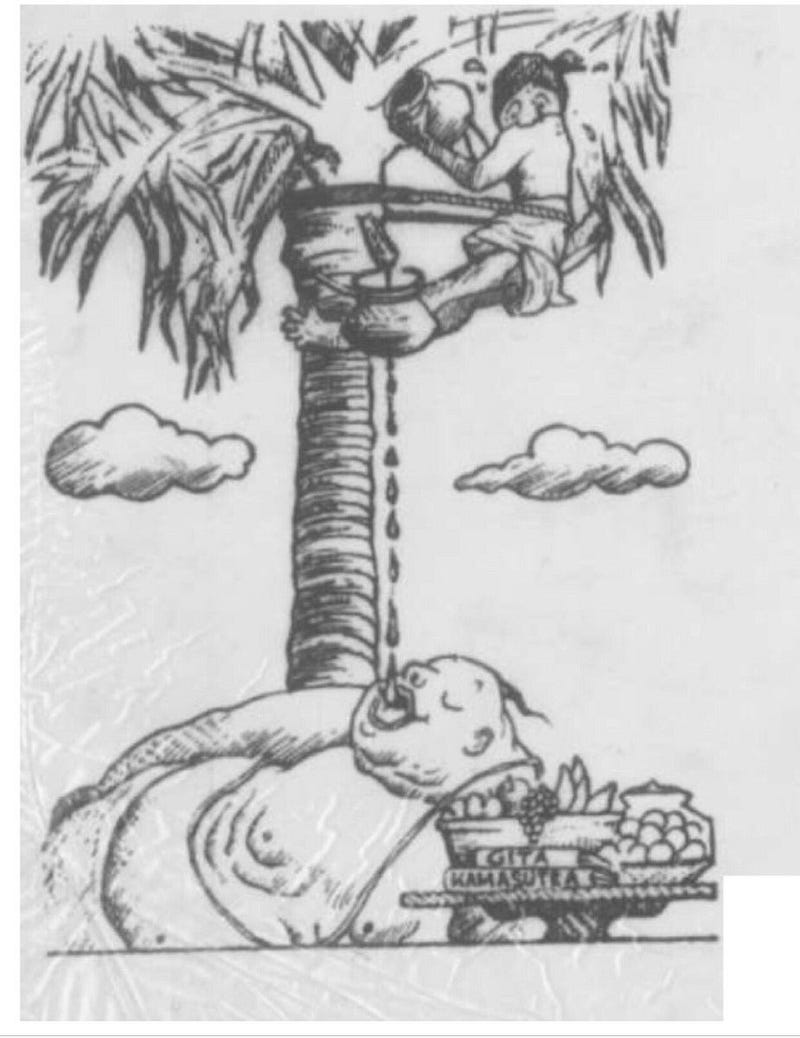Kancha Ilaiah’s tirade against the trading community in his latest offering “Samajika Smugglerlu Komatollu” (Vysyas are Social Smugglers) is a unique blend of misplaced Marxist lens with blinding Hinduphobic tint. Which precisely explains why his theories, each competing with the other in the race to logical abyss, are lapped up by the left-liberal world and Christian missionaries alike.
Eyelids become heavy when he refers to himself as a successor to Buddha, Phule and Ambedkar in the recent spate of interviews to Telugu media. If only he had bothered to research a fraction of what Ambedkar did, we would have had a less pompous, but more measured ‘intellectual’. Speaking of ‘intellectual’ (that’s how he refers to himself!), it is instantly clear to any objective viewer that what passes on as a social scientist’s observations are actually nothing more than Hindu hatred in its purest form.
Since he repeatedly refers to his “Why I am not a Hindu” as some sort of modern bible, standing besides phenomenal works like Bertrend Russell’s “Why I am not a Christian” and Ibn Warraq’s “Why I am not a Muslim”, I forced myself to read it first.
If I had anticipated (against my better sense) that it would be intellectually and logically rigorous treatise, the very cover-page dampened my spirits.

If you’re wondering as to what this is about, Ilaiah has thankfully made it amply clear in the very back-cover.

If a picture is worth thousand words, here’s exhibit A:

Not since Nazi caricaturing of Jews, had the world seen such a vile characterization of an entire community. And we know where that lead to. Not that Ilaiah is subtle about his plans for them either. He makes it clear in so many words how he wishes to treat Brahmins, whom he considers the brain of Hinduism, which in turn is, “solely responsible for the tragedy of this country”.
Samples:
it is important to capture the Hindu temples by expelling the Brahmins from them as there is a lot of wealth in the temples in the form of gold, silver and land. This wealth has to be seized.
Productive Dalitbahujan culture should constantly be privileged over Hindu ‘swaha’ culture. The thousands of existing temples could be converted into public education centres, where the Dalitbahujans begin to reschool the ‘upper’ castes.
Yet another major area of Dalitization will be to push the Brahmin-Baniyas into productive work, whether it is rural or urban. Both men and women of the so-called upper castes will resist this with all the strength at their command. This is because among them Hinduism has destroyed all positive elements that normally exist in a human being.
No ruling class in the world is as dehumanized as the Indian brahminical castes. They can be rehumanized only by pushing them into productive work and by completely diverting their attention from the temple, the office, power-seeking, and so on.
the anti-caste revolution in India may take a more tortuous course than even the ‘proletarian cultural revolution’ did in China. The Brahmins will make it so difficult that even if they are asked to undertake productive work, they will shout from their rooftops that atrocities on the ‘intellectuals’ are on the increase.
Now, how does Ilaiah wish to accomplish the above in a democratic nation? How does he propose to “push” brahmins into “productive work”? Lest you’re into a thinking-mode, let me remind you that the answer lies in the very next quote — “cultural revolution” in the lines of China. That is, violent force, including mass extermination, displacement, forced bonded labor among others. Not a far cry from Nazis at all, in fact even more ominous, given that communist excesses are systematically whitewashed by left-liberals.
Given how Ilaiah wishes to treat Brahmins if he has his way, he has the gall to preach this in the introduction: “Let me make it clear, however, that I am not writing this book to convince suspicious brahminical minds; I am writing this book for all those who have open minds.”
What is “Productive Work”?
Ilaiah conflates “production” to a very narrow set of activities happening within a semi-agrarian society. He doesn’t even get to the level of Marxist philosophy that values ideologically-driven intellectualism while undermining intellectual workers. The prerequisite for being a “productive caste”, according to him, is the element of physical labor in the work. Those not using physical labor, irrespective of what they accomplish for the society, are parasitic constituents.
Unsurprisingly, his heart is consumed by hatred for Brahmins and Banias, whom he accuses of being non-productive castes. This is precisely why he brands Banias (komatollu) as being social smugglers, because the only productive work he recognizes is that which involves physical labor.
For his shoddy grasp of history (which merits a separate essay), he fails to understand the evolution of industry through ages. The culture he refers to as Dalitbahujan, belongs to a certain timeframe of human evolution wherein the trade system was simplistic. The culture whose superiority he admiringly contrasts with ‘brahminical’ system, can exist only in a predominantly barter-based trade system. The more the system advances, it’s impossible to keep up with changes using the same system.
A case in point: USSR’s fall was explained by futurist Alvin Toffler as a result of collision with future. USSR’s centralized economy, with top-down flow of information suited industrial economy, but was incapable of adapting to knowledge economy which required free flow of information. Their failure to recognize the work of white collar jobs, as against blue collar manufacturing era jobs was their Achilles heel.
Applying Ilaiah’s definition will put today’s IT workers squarely in the ‘non-productive’ class. I doubt if he understands the nature of digital assets; a popular website domain-name, an intangible entity, can probably sell for a higher price than a piece of land (tangible). Why, in the present role of a Professor, Ilaiah — by his own definition — most certainly is “non-productive”.
In the present world, the work he calls ‘productive’ can exist only in less-advanced societies where the power of technology isn’t being exploited. It belongs to a passage of time in history, not in the present.
Brahmins and Banias verily contributed to the society in their own way, as knowledge-workers.
Politicizing Aryan Invasion Theory to the hilt
Ilaiah bases his Hindu-hatred in Aryan Invasion Theory, which stands on the last leg of credibility today. However, that doesn’t deter Ilaiah who boldly proclaims all dalits as successors of Harappa civilization, which was supposedly overthrown by Aryan (Hindu) invaders. Unable to withstand constant examination of “Invasion” theory, many of its proponents have toned it down to Aryan “Migration” Theory.
Difficult as it may be for us to believe today, the theory of Aryan-Dravidian divide in lines of race was a 19th century phenomena. Before Christian missionaries exploited this pseudo-scientific theory for conversions, no Indian thought of himself as belonging to a either Aryan or Dravidian race.
As Koenraad Elst observes, “these anti-Hindu forces are exploiting the AIT to the hilt, infusing crank racism in vast doses into India’s body politic”. Before the term ‘adivasi’ (original inhabitants) was popularized by British, mainstream Hindus referred to them as vanavasi (forest dwelling people). While there may be certain differences in rites and rituals, they distinctly belonged to the pluralistic Indic tent of traditions.
To quote Mahatma Gandhi, “ I know that despite being described as animists these tribes have from time immemorial been absorbed in Hinduism. They are, like the indigenous medicine, of the soil and their roots lie deep there.”
To belabor this point further, let’s ask ourselves why Hindus didn’t try to convert them to ‘brahminical’ way, whereas the Christian missionary soul-harvesting has resulted in tensions. The Christian missionary Graham Stains was allegedly killed by tribals who objected to his destruction of communities through conversion. Tribals are not Hindus, except when they are. Missionary global enterprise lost no time is characterizing this as attack as another face of Hindutva based activism.
Misunderstanding Caste
Caste is Portuguese corruption of jaati and varna put together. Traditionally, there have been instances where a jaati transitioned to another varna . Present day examples include Brahmins who run Sulabh Sauchalay. It is foolish to think the castes were the same water-tight compartments they are today. Many so-called lower castes of today were highly influential in medieval times. Significantly, except few rare instances, Brahmins were never the ruling caste.
It is impossible for any particular class to impose it on others. No less than Ambedkar, who cannot be accused of having pro-Hindu tilt, said:
The spread and growth of the Caste system is too gigantic a task to be achieved by the power or cunning of an individual or of a class. Similar in argument is the theory that the Brahmins created the Caste... it is incorrect in thought and malicious in intent. The Brahmins may have been guilty of many things, and I dare say they were, but the imposing of the caste system on the non-Brahmin population was beyond their mettle. They may have helped the process by their glib philosophy, but they certainly could not have pushed their scheme beyond their own confines.
Why does Ilaiah, who fancies himself as the ‘intellectual’ successor to Ambedkar, indulge in selective amnesia when he quotes the great thinker?
The madness
I mentioned about the Christian and Muslim counterparts of this “Why I am Not…” series earlier in the essay. Now, these were written by apostates who had experiential knowledge of their childhood religion. Not so with Ilaiah who proudly flaunts his ignorance about the subject he's criticizing. Other eminent people have written about how the book betrays his total lack of knowledge of bare facts, let alone philosophical interpretations.
Let me add a telling slip that indicates the epicenter of his ideology: to rationalize why he's not a Hindu, he explains that his parents "never paid a religion tax, something which all feudal religions normally demand." Surely, Ilaiah has swallowed the missionary line in strong dose, for he cannot think of a religion that doesn't demand "religion" tax. Anyone with even a peripheral understanding of Hinduism will know that it's by far a highly decentralized system, with no pope or mullah dictating terms as to how their communities should conduct their lives.
Elsewhere he says of Hindu marriage, ".. ceremony ends when all who are present touch the feet of the priest: a brazenly shameful act. It is not a voluntary act. It is a subtly manipulated, coercive act." This prompted an instant recall of one of his many interviews where he traces the origin of Brahmin-hatred. He says when his mother expired, the priest - after performing rites - asked Ilaiah to touch his feet, which he found to be abhorrent.
It seems to me that small events like this, evoked in a kid a sense of hatred, which instead of being corrected by worldly experience, has metamorphosed into gigantic, delusional and paranoiac levels.
Look at how he characterizes Banias:
..a Hindu Baniya market presupposes a lie to be part of its sacred form as well as its business culture.. A Baniya is said to be within his Hindu morality—in spite of the fact that he misleads his customers and tells lies about his margins of profit. He will retain his Hindu morality even if he underweighs while selling and overweighs while buying. He will be within his Hindu morality even if he over-rates the quality of the commodity he sells, or under-rates the quality while buying. A Baniya is extremely Hinduistic. Even the prices of commodities or grain and pulses change based on the caste of the customer. For example, for the same grain a Maadigaa gets paid less than a Reddy gets. While buying from the Baniya, the lower the caste of the customer, the higher would be the price, and while selling it would be the opposite.
This is closer to a Christian missionary pamphlet for a simpleton, with caricaturing that veers into anti-semitism-like territory.
The Method Behind the Madness
How can this kind of anti-Hindu polemic, shorn of rigor and logic, be portrayed as a soul-searching and stirring work? What gives?
Now we're talking!
Recently, he has re-christened (pun intended) himself as Kancha Ilaiah 'Shepherd'. The addition was ostensibly to discard authoritarian Sanskrit names, and tell the world his ancestral profession through a more democratic 'English'. The Biblic connotation of 'shepherd' is not lost on any attentive observer!
In an interview to Christianity Today, he says, "I have been saying and writing in one of my books that Hinduism is a kind of spiritual fascism because the Hindu books say that Aryans wrote that, and Nazi Germany Hitler believed he belonged to an Aryan race. So the symbols that Hindus and Aryan Germans are the same, the swastika and the concept of a few people always being superior to the other..."
Has he totally lost it? Nazis misappropriated some Indic elements including Swastika to provide a cultural backbone for their imperialist designs. How are Hindus in any way related to what Hitler's Germany did to others?
In his seminal book "Breaking India", Rajiv Malhotra discusses Ilaiah's role in aligning with the breaking India forces. Quoting the book, about how a Texas-based organization called "Gospel for Asia" introduced him:
Gospel for Asia is pleased to host Dr Kancha Ilaiah, one of India’s most influential human rights leaders. . . . What Martin Luther King, Jr. meant to the civil rights movement in this country, Dr Ilaiah means to the civil rights movement in India today. . . . In his role as consultant to the All India Christian Council, he advises leaders on the socio-economic, religious, and political conditions among India’s lower castes. (emphasis mine)
Malhotra goes on to observe that:
In 2005, DFN representatives, along with Kancha Ilaiah, provided testimony to a US government subcommittee on human rights, in which they advocated US interventionist policies against India. The hearing was titled, ‘Equality and Justice for 200 Million Victims of the Caste System’.64 The chairman of the US Commission on Global Human Rights supported DFN’s position, saying, ‘Converts to Christianity and Christian missionaries are particularly targeted, and violence against Christians often goes unpunished’.
One can understand that people can have genuine grievances against the Indian system. Nobody is claiming India is all-perfect. But to denigrate India in front of foreigners? To seek to undermine the Indian State's sovereignty by imploring foreign interventionism? Have we learnt nothing at all from 200 years of slavery?
Connecting the dots, what elevates Ilaiah has nothing to do with the substance of his writings, which makes Hitler's Mein Kamph look infinitely subtler and indeed a masterpiece! He's being coronated as a human-rights champion simply because he is an instrument of propaganda in the hands of the global conversion war machine.
Comments
Post a Comment